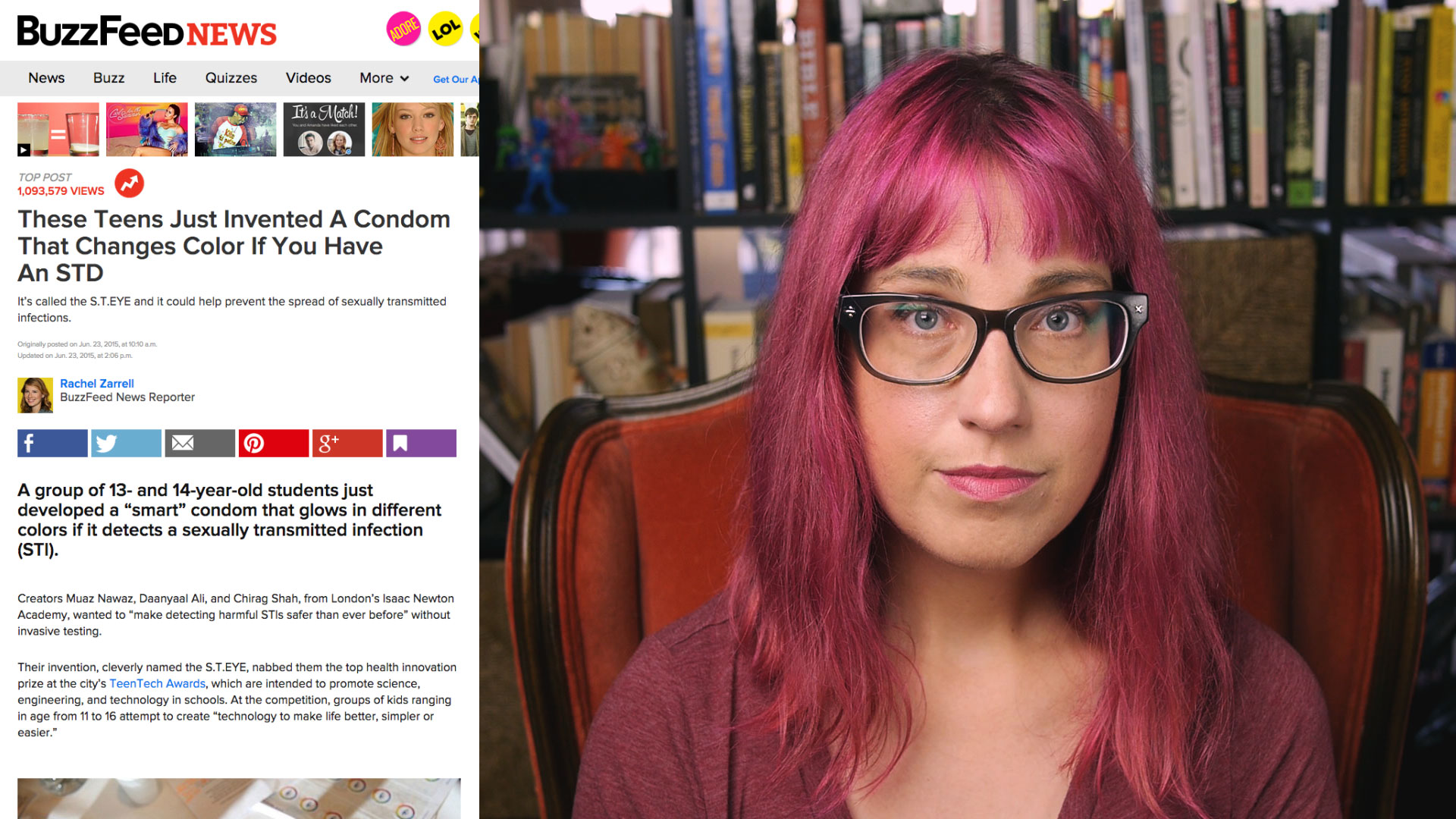
Support more videos like this at patreon.com/rebecca!
I recently stumbled across a Buzzfeed article headlined “These Teens Just Invented A Condom That Changes Color If You Have An STD”, which would be truly amazing if it were at all true. Unfortunately, saying they invented an STD-detecting condom would be the same as me saying I just invented a tiny American flag pin that changes color every time a politician lies, which is a thing I just thought up and have no actual way to make into reality. Unfortunately.
I want to be absolutely clear here that my problem is not with the teenagers in question, who are three 13- and 14-year old students at Isaac Newton Academy in London. It’s awesome that they’re thinking critically about sexually transmitted diseases and how technology can make the world a better place, and I’m glad they won 1,000 GBP and a trip to Buckingham Palace for having the best idea in the TeenTech Awards.
My problem is with outlets like Buzzfeed and the Independent, and the Washington Post reporting on this as though it’s a real product that actually exists. Why am I so annoyed? Because not only does this condom not exist, but with our current and potential near-future technology it will continue not existing for a very long time.
Most STD tests, like the ones for HIV or syphilis, actually require a blood sample, not semen, vaginal fluid, or anything coming out of your mouth or anus. The tests that could potentially work with a condom would still need more than a few seconds or even minutes to work, and they’d still need to be evaluated by someone who knows what they’re doing in order to mean anything.
So, as kooky and fun as the idea is, we are nowhere near to being able to build something like that.
Instead, there are much easier ways to try to reduce the stigma of STIs while encouraging more people to get tested, and as luck should have it one great option just launched: Planned Parenthood has created an STD app, which allows you to order a discreet test for chlamydia and gonorrhea that you can do at home. You mail off the kit and someone will evaluate it. In the meanwhile, you can use the app to ask doctors questions. If it comes back positive for one of the diseases, you’ll get treatment — if it’s chlamydia you can get a prescription to take at home, and gonorrhea can be treated in a local clinic.
That’s a simple way to help people who don’t have easy access to a doctor or who are embarrassed. The problem is that it’s expensive, at $149/kit. So, a true innovation in STI testing would be to figure out a way to lower the cost of those kits and make sure everyone has access to them as quickly and easily as possible.





Rebecca Watson,
The idea actually sounds kind of dumb to me. Wouldn’t you want to know you had the disease before you decided to have sex with someone? Isn’t that a major point of detecting sexually transmitted the diseases, so that you don’t spread them?
For people who have multiple partners in a month, it isn’t practical to get tested between each partner. Even for people in the “high risk” category, the recommendation is testing every 3 months. These condoms would make it possible to be tested after every encounter. If STI detecting condoms existed and felt about the same as the ones I use, I’d use them with new partners and in open relationships.
As to feasibility, they’ve made computer chips that can detect viruses by the specific proteins on their capsids.
http://news.byu.edu/archive09-Dec-labonachip.aspx
If they could make a circuit thin enough to fit on both sides of a condom and not change the feel, then you could theoretically develop condoms that react visibly to viruses. They’re working on flexible circuits, so that part may be possible. As for bacteria, I’m going off a single microbiology class, but I don’t think that the structures in their cell walls would be distinctive enough to allow identification on those alone, meaning the protein detecting computer chips wouldn’t’ work. The process we used for microbe identification in class involved culturing the bacteria, and that takes hours to days, so that wouldn’t work with the condoms.
Jac,
Okay, I think I see what you’re getting at.
I love the idea even if it’s not practical in the near future. Of course, those who wear condoms are already doing a lot to prevent STDs.
“Creatively” in the video, “critically” in the transcript. That kind of bugged me.
But yeah, what needs to be done is drive down the cost of testing. Also, remove the stigma of buying a small or average condom, rather than a Magnum XL that slips off.